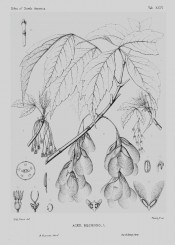Acer negundo L.
Fully hardy, fast-growing, upright, deciduous tree with pinnate leaves with light green leaflets, turning yellow in autumn. Male and female flowers are borne on separate trees. To 15m. [RHSE, Hortus, Hilliers’].
Horticultural & Botanical History
Botanically described by Linnaeus as Acer negundo, the name by which it is generally known today [Sp.Pl. p.1056/1753].
‘Acer Negundo is one of the most widely distributed, and in some parts of the country one of the commonest, trees of the North American forest. It occurs on the banks of the Winooski River and of Lake Champlain in Vermont, on the shores of Cayuga Lake in New York, in eastern Pennsylvania, and ranges to Hernando County, Florida, and northwestward to Dog’s Head Lake in Winnipeg and along the southern branch of the Saskatchewan to the eastern base of the Rocky Mountains; in the United States it is found as far west as the eastern slopes of the Rocky Mountains in Montana, the Wahsatch Mountains in Utah, western Texas, New Mexico, and eastern Arizona, extending south along the mountain ranges of northeastern Mexico. The Box Elder inhabits the banks of streams and lakes and the borders of swamps; it is comparatively rare in all the region east of the Appalachian Mountains, and is much more common in the basin of the Mississippi, being most abundant and reaching its greatest size in the valleys of the streams which flow into the lower Ohio River. Here it flourishes in the deep rich moist and often inundated bottom-lands, forming a large part of the growth under the Oaks, Hickories, and Gum-trees, which in such situations rise to a great height. It is mingled with Willows, the Elm, and the Hackberry on the banks of the streams which flow through the midcontinental plateau almost to the western limit of tree-growth, while in the central mountain region it is confined to valleys five or six thousand feet above the level of the sea. […]
The wood of Acer Negundo is light, soft, close-grained, but not very strong; it is creamy white, with thick, hardly distinguishable sapwood, and contains numerous medullary rays. The specific gravity of the absolutely dry wood is 0.4328, a cubic foot weighing 26.97 pounds. The specific gravity of the wood of a tree grown in Contra Costa County, California, is 0.4821, a cubic foot weighing 30.04 pounds. The wood of the Box Elder is occasionally manufactured into cheap furniture, and is sometimes used for the interior finish of houses, for wooden ware, cooperage, and paper pulp. Small quantities of maple-sugar are occasionally made from this tree.
Acer Negundo was one of the first North American trees known in Europe; Ray first described it in the Historia Plantarum, published in 1688, from plants cultivated by Bishop Compton in his garden at Fulham near London. It was discovered in California in the neighborhood of Monterey by David Douglas.
The rapid growth made by the Box Elder in good soil, its hardiness, and the cheerful color of its graceful foliage have always made it a favorite tree in gardens, although it is not long-lived or very stately or handsome in old age; and in the United States it has been planted in great numbers of late years, especially in the naturally treeless central part ofthe continent, where it supports better than many other trees the severe climatic changes and the deficiency of moisture. Many varieties have appeared in nurseries, and one of them, producing leaves marked with broad blotches of pure white, is now a popular garden-plant in most European countries.’ [Sargent – Silva of North America vol.2, p.112/1891]. The illustration used here is tab.XCVI from this publication.
Negundo fraxinifolium was introduced to Britain in 1688. Two varieties are listed in Johnson’s Dictionary, crispum, curly-leaved, and violaceum. [JD].
History at Camden Park
Grown in the gardens before 1843. Listed in all published catalogues [T.13/1843].
Notes
Now considered a potentially serious weed in Australia. Naturalised in cooler parts of NSW. [FNSW].
Negundium americanum DC. ex Loud. is regarded by some as a synonym of Acer negundo L. but this is unresolved.
Published Feb 19, 2009 - 04:58 PM | Last updated Jun 14, 2011 - 04:38 PM
| Family | Aceraceae |
|---|---|
| Category | |
| Region of origin | North America |
| Synonyms |
|
| Common Name | Ash-leaved maple, Box elder |
| Name in the Camden Park Record | Acer negundo - ash-leaved Maple |
| Confidence level | high |
